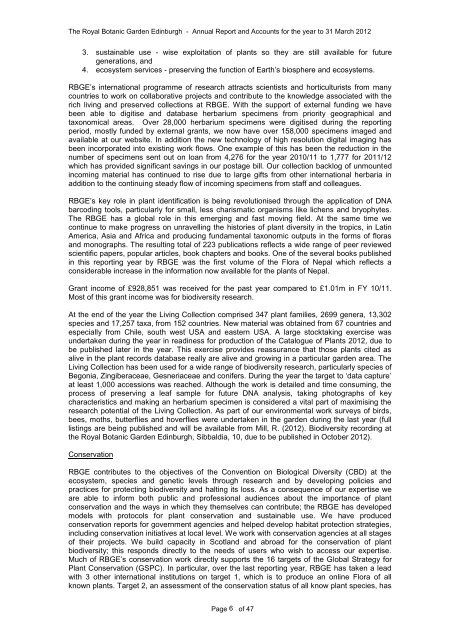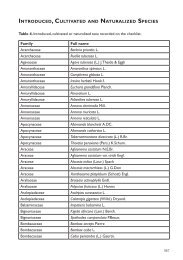Annual Accounts 2011-2012 (pdf - 973 kB) - Royal Botanic Garden ...
Annual Accounts 2011-2012 (pdf - 973 kB) - Royal Botanic Garden ...
Annual Accounts 2011-2012 (pdf - 973 kB) - Royal Botanic Garden ...
You also want an ePaper? Increase the reach of your titles
YUMPU automatically turns print PDFs into web optimized ePapers that Google loves.
The <strong>Royal</strong> <strong>Botanic</strong> <strong>Garden</strong> Edinburgh - <strong>Annual</strong> Report and <strong>Accounts</strong> for the year to 31 March <strong>2012</strong><br />
3. sustainable use - wise exploitation of plants so they are still available for future<br />
generations, and<br />
4. ecosystem services - preserving the function of Earth’s biosphere and ecosystems.<br />
RBGE’s international programme of research attracts scientists and horticulturists from many<br />
countries to work on collaborative projects and contribute to the knowledge associated with the<br />
rich living and preserved collections at RBGE. With the support of external funding we have<br />
been able to digitise and database herbarium specimens from priority geographical and<br />
taxonomical areas. Over 28,000 herbarium specimens were digitised during the reporting<br />
period, mostly funded by external grants, we now have over 158,000 specimens imaged and<br />
available at our website. In addition the new technology of high resolution digital imaging has<br />
been incorporated into existing work flows. One example of this has been the reduction in the<br />
number of specimens sent out on loan from 4,276 for the year 2010/11 to 1,777 for <strong>2011</strong>/12<br />
which has provided significant savings in our postage bill. Our collection backlog of unmounted<br />
incoming material has continued to rise due to large gifts from other international herbaria in<br />
addition to the continuing steady flow of incoming specimens from staff and colleagues.<br />
RBGE’s key role in plant identification is being revolutionised through the application of DNA<br />
barcoding tools, particularly for small, less charismatic organisms like lichens and bryophytes.<br />
The RBGE has a global role in this emerging and fast moving field. At the same time we<br />
continue to make progress on unravelling the histories of plant diversity in the tropics, in Latin<br />
America, Asia and Africa and producing fundamental taxonomic outputs in the forms of floras<br />
and monographs. The resulting total of 223 publications reflects a wide range of peer reviewed<br />
scientific papers, popular articles, book chapters and books. One of the several books published<br />
in this reporting year by RBGE was the first volume of the Flora of Nepal which reflects a<br />
considerable increase in the information now available for the plants of Nepal.<br />
Grant income of £928,851 was received for the past year compared to £1.01m in FY 10/11.<br />
Most of this grant income was for biodiversity research.<br />
At the end of the year the Living Collection comprised 347 plant families, 2699 genera, 13,302<br />
species and 17,257 taxa, from 152 countries. New material was obtained from 67 countries and<br />
especially from Chile, south west USA and eastern USA. A large stocktaking exercise was<br />
undertaken during the year in readiness for production of the Catalogue of Plants <strong>2012</strong>, due to<br />
be published later in the year. This exercise provides reassurance that those plants cited as<br />
alive in the plant records database really are alive and growing in a particular garden area. The<br />
Living Collection has been used for a wide range of biodiversity research, particularly species of<br />
Begonia, Zingiberaceae, Gesneriaceae and conifers. During the year the target to ‘data capture’<br />
at least 1,000 accessions was reached. Although the work is detailed and time consuming, the<br />
process of preserving a leaf sample for future DNA analysis, taking photographs of key<br />
characteristics and making an herbarium specimen is considered a vital part of maximising the<br />
research potential of the Living Collection. As part of our environmental work surveys of birds,<br />
bees, moths, butterflies and hoverflies were undertaken in the garden during the last year (full<br />
listings are being published and will be available from Mill, R. (<strong>2012</strong>). Biodiversity recording at<br />
the <strong>Royal</strong> <strong>Botanic</strong> <strong>Garden</strong> Edinburgh, Sibbaldia, 10, due to be published in October <strong>2012</strong>).<br />
Conservation<br />
RBGE contributes to the objectives of the Convention on Biological Diversity (CBD) at the<br />
ecosystem, species and genetic levels through research and by developing policies and<br />
practices for protecting biodiversity and halting its loss. As a consequence of our expertise we<br />
are able to inform both public and professional audiences about the importance of plant<br />
conservation and the ways in which they themselves can contribute; the RBGE has developed<br />
models with protocols for plant conservation and sustainable use. We have produced<br />
conservation reports for government agencies and helped develop habitat protection strategies,<br />
including conservation initiatives at local level. We work with conservation agencies at all stages<br />
of their projects. We build capacity in Scotland and abroad for the conservation of plant<br />
biodiversity; this responds directly to the needs of users who wish to access our expertise.<br />
Much of RBGE’s conservation work directly supports the 16 targets of the Global Strategy for<br />
Plant Conservation (GSPC). In particular, over the last reporting year, RBGE has taken a lead<br />
with 3 other international institutions on target 1, which is to produce an online Flora of all<br />
known plants. Target 2, an assessment of the conservation status of all know plant species, has<br />
Page 6 of 47





